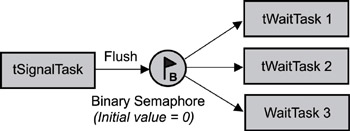Книга: Real-Time Concepts for Embedded Systems
6.4.2 Multiple-Task Wait-and-Signal Synchronization
6.4.2 Multiple-Task Wait-and-Signal Synchronization
When coordinating the synchronization of more than two tasks, use the flush operation on the task-waiting list of a binary semaphore, as shown in Figure 6.6.

Figure 6.6: Wait-and-signal synchronization between multiple tasks.
As in the previous case, the binary semaphore is initially unavailable (value of 0). The higher priority tWaitTasks 1, 2, and 3 all do some processing; when they are done, they try to acquire the unavailable semaphore and, as a result, block. This action gives tSignalTask a chance to complete its processing and execute a flush command on the semaphore, effectively unblocking the three tWaitTasks, as shown in Listing 6.2. Note that similar code is used for tWaitTask 1, 2, and 3.
Listing 6.2: Pseudo code for wait-and-signal synchronization.
tWaitTask () {
:
Do some processing specific to task
Acquire binary semaphore token
:
}
tSignalTask () {
:
Do some processing Flush binary semaphore's task-waiting list
:
}
Because the tWaitTasks' priorities are higher than tSignalTask's priority, as soon as the semaphore is released, one of the higher priority tWaitTasks preempts tSignalTask and starts to execute.
Note that in the wait-and-signal synchronization shown in Figure 6.6 the value of the binary semaphore after the flush operation is implementation dependent. Therefore, the return value of the acquire operation must be properly checked to see if either a return-from-flush or an error condition has occurred.
- 6.4.3 Credit-Tracking Synchronization
- 6.4.6 Multiple Shared-Resource-Access Synchronization
- 6.4.1 Wait-and-Signal Synchronization
- Разработка приложений баз данных InterBase на Borland Delphi
- LOCK SIGNAL
- Open Source Insight and Discussion
- Introduction to Microprocessors and Microcontrollers
- Chapter 6. Traversing of tables and chains
- Chapter 8. Saving and restoring large rule-sets
- Chapter 11. Iptables targets and jumps
- Chapter 5 Installing and Configuring VirtualCenter 2.0
- Chapter 16. Commercial products based on Linux, iptables and netfilter




